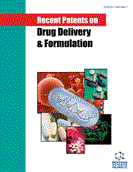Abstract
Bio-molecules are the most important target to be considered while designing any drug delivery system. The logic lies in using such bio-sensing or bio-mimicking systems in their formulations that can mimic the active site of those receptors to which the drug is going to bind. Polymers mimicking the active site of target enzymes are regarded as bio-inspired polymers and can be used to ameliorate many diseased conditions. Nowadays, this strategy is also being adopted against diabetes and its complications. Under hyperglycemic conditions, many pathways get activated which are responsible for the progression of diabetes-associated secondary complications viz. retinopathy, neuropathy, and nephropathy. The enzymes involved in the progression of these complications can be mimicked for their effective management. For an instance, Aldose Reductase (ALR2), a rate-limiting enzyme of the polyol pathway (downstream pathway) which gets over-activated under hyperglycemic condition is reported to be mimicked by using polymers which are having same functionalities in their structure. This review aims at critically appraising reports in which target mimicking bio-inspired formulations have been envisaged against diabetes and its complications. The information summarized in this review will provide an idea about the bio-sensing approaches utilized to manage blood glucose level and the utility of bio-inspired polymers for the management of diabetic complications (DC). Such type of information may be beneficial to pharmaceutical companies and academia for better development of targeted drug delivery systems with sustained-release property against these diseased conditions.
Keywords: Bio-inspired, diabetes, polymer, retinopathy, neuropathy, nephropathy, ALR2.
[http://dx.doi.org/10.2337/dc13-S067] [PMID: 23264425]
[http://dx.doi.org/10.1016/j.diabres.2018.02.023] [PMID: 29496507]
[http://dx.doi.org/10.1007/s00125-014-3462-y] [PMID: 25481708]
[http://dx.doi.org/10.2337/diabetes.54.6.1615] [PMID: 15919781]
[http://dx.doi.org/10.1038/414813a] [PMID: 11742414]
[http://dx.doi.org/10.1016/0093-691X(91)90312-2] [PMID: 16726969]
[http://dx.doi.org/10.1016/0009-9120(81)90105-3] [PMID: 7237737]
[http://dx.doi.org/10.5001/omj.2012.68] [PMID: 23071876]
[http://dx.doi.org/10.7860/JCDR/2018/32716.11444]
[http://dx.doi.org/10.1016/j.jmgm.2019.06.012] [PMID: 31252365]
[http://dx.doi.org/10.1111/1440-1681.12332] [PMID: 25360831]
[http://dx.doi.org/10.1111/cbdd.13369] [PMID: 30030901]
[http://dx.doi.org/10.2337/dc17-2364] [PMID: 29263163]
[http://dx.doi.org/10.2337/dc16-2042] [PMID: 27999003]
[http://dx.doi.org/10.1016/j.tem.2016.07.002] [PMID: 27470431]
[http://dx.doi.org/10.1073/pnas.1508522112] [PMID: 26598694]
[http://dx.doi.org/10.3390/polym2030323]
[http://dx.doi.org/10.1039/C4SC03392B] [PMID: 28694944]
[http://dx.doi.org/10.1016/j.actbio.2015.08.043] [PMID: 26318801]
[http://dx.doi.org/10.1021/acs.chemrev.5b00344] [PMID: 26583535]
[http://dx.doi.org/10.1002/aic.11779] [PMID: 26500352]
[http://dx.doi.org/10.1016/S1359-6446(02)02255-9] [PMID: 12047857]
[http://dx.doi.org/10.1177/193229681200600316] [PMID: 22768892]
[http://dx.doi.org/10.1089/dia.2014.0009] [PMID: 24801544]
[http://dx.doi.org/10.1021/bm500364a] [PMID: 25268758]
[http://dx.doi.org/10.1021/acsnano.7b01809] [PMID: 28437610]
[http://dx.doi.org/10.1002/adfm.201001762]
[http://dx.doi.org/10.1021/nn1008319] [PMID: 20731458]
[http://dx.doi.org/10.1177/193229680900300623] [PMID: 20144397]
[http://dx.doi.org/10.1038/s41467-017-01764-1] [PMID: 29176623]
[http://dx.doi.org/10.1039/C9NJ00888H]
[http://dx.doi.org/10.1016/0039-6257(79)90158-9] [PMID: 380030]
[http://dx.doi.org/10.3389/fphar.2012.00188] [PMID: 23125835]
[PMID: 1945278]
[http://dx.doi.org/10.1517/17425247.4.4.371] [PMID: 17683251]
[http://dx.doi.org/10.1016/j.ejpb.2017.10.016] [PMID: 29079419]
[http://dx.doi.org/10.1007/s10965-018-1647-7]
[http://dx.doi.org/10.1002/term.2880] [PMID: 31066518]
[http://dx.doi.org/10.1016/j.actbio.2018.11.020] [PMID: 30448434]
[http://dx.doi.org/10.1046/j.1432-1327.1998.2560310.x]
[http://dx.doi.org/10.1046/j.1432-1327.1998.2560310.x] [PMID: 9760169]
[http://dx.doi.org/10.1002/prot.20021] [PMID: 15162486]
[http://dx.doi.org/10.1021/bi00174a006] [PMID: 8117658]
[http://dx.doi.org/10.1080/13543776.2019.1582646] [PMID: 30760060]
[http://dx.doi.org/10.1098/rsif.2010.0190.focus] [PMID: 20519214]
[http://dx.doi.org/10.1016/j.cherd.2015.09.003]
[http://dx.doi.org/10.1002/prot.21371] [PMID: 17523187]
[http://dx.doi.org/10.1021/acs.chemrev.6b00163] [PMID: 27333362]
[http://dx.doi.org/10.1021/jp062700h] [PMID: 16884212]
[http://dx.doi.org/10.1016/j.memsci.2011.08.030]
[http://dx.doi.org/10.1016/j.memsci.2011.08.030]
 19
19
















